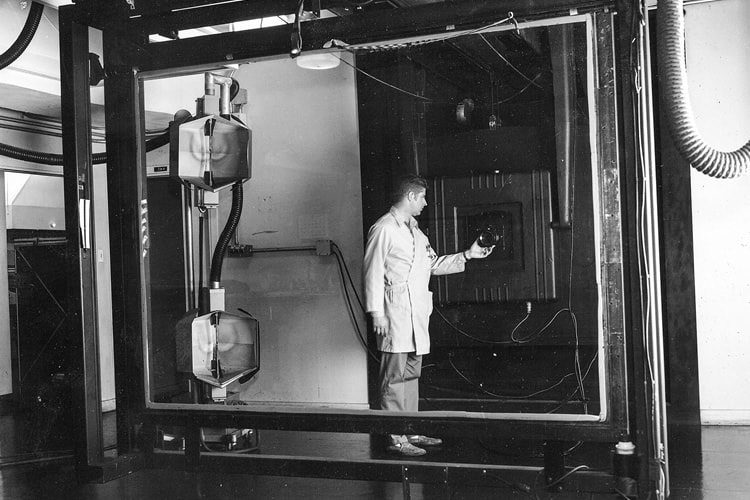The Science of Instagram
In the world of creativity, it is usually assumed that the popularity of an artist (such as a photographer) is entirely dependent on his or her innate ability. The received wisdom states that no formula for success can be bottled and learned, nor picked apart and analysed like the on-field manoeuvres of a football team.
The cynic might point out the financial benefits of maintaining this perception. There is nonetheless plenty of truth in the notion that a brilliantly creative brain can produce work that is indefinably attractive.

image by U.S. Geological Survey
Except, we are now in the age of big data, where vast repositories of information about our daily activities can be accumulated, and their contents meticulously searched for trends. It means analysis on a scale that has never before been achievable. In the case of photography, it means that the world’s photographic output – as seen on networks such as Flickr and Instagram – can come under the algorithmic microscope for the very first time, and the results are fascinating.
Although the humble human eye might be unable to distinguish the characteristics of a popular picture, it would seem that an algorithm can.
Scientific Evidence
The average hobbyist photographer has no interest in such data, of course. But as photo sharing has continued to boom, businesses increasingly share images, in the hope that engagement – by way of likes, comments and followers – will improve brand affinity, and even boost sales.
For some it has worked, while for others, it has been a waste of time. Companies who fall into the latter category increasingly turn to firms such as Curalate – specialists in maximising the returns of visual networking. To take the role of consultant, Curalate needs to know what “works” and what doesn’t, so they have created their own algorithm. The company’s most recent study scrutinised eight million Instagram images for thirty different attributes, before picking up the necessary engagement data for human feedback.
The results are certainly interesting for those of us who pay close attention to composition. Images predominantly filled with cooler tones apparently fare better than those with a yellow or orange theme. Similarly, a frame dominated by a single hue will, statistically, receive forty per cent more likes than a photo made from a paint factory’s worth of colours. Depth is also valued, as is brightness and muted saturation, but the trump card appears to be texture, which garners seventy-nine per cent more adulation than images which appear smooth.
I’m not suggesting you should rush out of your front door in search of a well-lit, all-faded-blue beach hut with a weather-beaten complexion. However, the implication of such research is that a photo might be engineered for popularity. So, should a budding photographer with grand ambitions keep their colour balance cool, or their textures rugged? Maybe. But what if that photographer wishes to share his or her images elsewhere?
Take Curalate’s own research on Pinterest. It goes against many of the reported preferences of the Instagram community as mentioned above. Reddish hues secure the most “pins“, and background space is shunned in favour of close-cropped impact. Most strikingly, pictures with silky smooth appearance are repinned 17 times more often than those with some roughness. It is a remarkable contrast.
Things are different again on Flickr. Aditya Khosla of MIT is well known for his image analysis; now, he and his team have turned their combined wits on 2.8 million images from the original, all-conquering photo sharing site. Some of the results dovetail with Curalate’s Instagram findings – texture is still a plus – but others simply serve to muddy the compositional waters. Cool tones are considered unfavourable, for instance, and subtlety gains less attention than vibrancy.
Potential Conclusions and Future Trends
The current generation of studies on image popularity only provides definitive answers on a network-by-network basis. It is, undoubtedly, useful information to have when deciding which site to post a picture on. MIT even have a rudimentary tool that will rate your picture’s attractiveness based on its knowledge of the Flickr community. The likelihood is that further, more advanced software of this sort will be developed, and then utilised by budding photographers wishing to make headway in today’s aggressively competitive online world. In time, such aids may even become necessary for success. But a more alarming possibility was raised at the end of Khosla’s MIT-backed paper – if equipped with future research, could a photographer warp their shooting style or post-processing to meet popular taste?
Before you or I attempt to answer that question, consider this one final piece of scientific research. A joint project in 2010 between the universities of Zhejiang (China) and Tel-Aviv (Israel) attempted to go beyond the rule of thirds, by allowing a computer to hone geometrics of composition. They used a small, but scientifically significant test group of human photo judges to rate the computer’s crops. Somehow, using limited data and numerous unintelligible mathematical formulae, the software had made the images more likeable.
What is more, it is only logical to assume that more data and four further years of computing technology could make such a program more accurate if constructed today. And that, surely, is only one step away from a camera which will guide your composition. Such an intrusion is a worrisome possibility.
But as the Sino-Israeli team points out, their software could not compete with human creativity. A photograph is more than the sum of its parts. It can tell a story, confuse or enlighten, bemuse or delight, and it is for this that an artist’s followers return for more. Make no mistake – the age of computer-guided popularism is on the way.
But for the time being, the work of an illogical brain will still hold the greatest allure.
